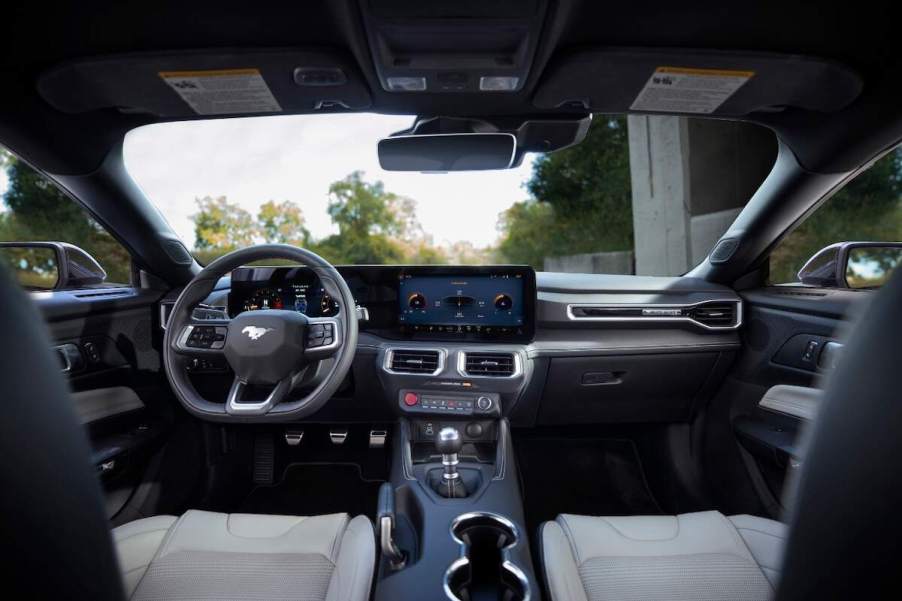
The 2024 Ford Mustang Is Adding a Key Feature as Standard
The 2024 Ford Mustang begins the iconic muscle car’s seventh generation. To usher in the new era, the Blue Oval has made several engine changes and broadened the suite of standard safety features. One noteworthy addition is post-collision braking, but it’s far from the only advanced driver-assistance system making the Mustang’s driving experience more comfortable and convenient than ever.
New 2024 Mustang features mark the next generation

The standard 2024 Mustang packs an upgraded 2.3-liter four-cylinder EcoBoost engine making 315 hp with 360 lb-ft of torque. It’s one of two new engines in a revamped powertrain lineup. The other is a 5.0-liter V8 harnessing 480 hp and 415 lb-ft of torque, found in the Mustang GT and the brand-new Dark Horse that replaces the Mach 1 variant.
The new Mustang also gets an exterior and interior makeover. The front and rear fascias, LED headlights, and grilles have been completely redone to give the car a boxier appearance than previous Mustangs. Hood struts are also now standard on every model. Three exterior colors are available (Vapor Blue Metallic, Yellow Splash Metallic, and the Dark Horse-exclusive Ember Blue Metallic), while two have been removed (Mischievous Purple Metallic and Fighter Jet Gray).
A 12.4-inch LCD digital display, a flat-bottomed steering wheel, and several new colorways headline the refreshed Mustang interior. Prices range from $30,920 for the EcoBoost Fastback to $63,265 for the Dark Horse Premium, but the MSRP increases for a fully loaded Mustang.
Post-collision braking is the highlight of the 2024 Mustang’s new driver assists

The upgrades to the 2024 Mustang also extend to the safety features. The legendary pony car has more driver-assist technology than its peers, notably post-collision braking, which now comes standard across all trim levels after not being available in the 2023 model.
Ford says the feature works by automatically applying brake pressure after a collision has occurred. Onboard sensors exchange information with the restraint module on certain actions — such as if an airbag deployed or the fuel cutoff switch was activated — and slow the Mustang to reduce the chances of injury, damage to the vehicle, or a secondary collision.
Post-collision braking is part of Ford Co-Pilot 360, a package of protective tools that includes:
- Automatic headlights and high beams
- Blind-spot information system with cross-traffic alerts and rear traffic indicators
- Lane-keeping system
- Pre-collision assist with automatic emergency braking
- Rear-view camera
- Rain-sensing wipers
- Rear parking sensors
In addition, Ford replaced the Sync 3 connectivity system with Sync 4 to provide navigation options and software updates to keep the Mustang’s systems up-to-date. Adaptive cruise control is also available as part of the Safe and Smart package for the EcoBoost and GT models.
Ford’s changes make the muscle car safer than ever

Recent Mustang editions were not lacking in the safety department. The 2023 model earned a perfect five-star rating from the National Highway Traffic Safety Administration. But the new additions help the pony car maintain modern standards and give drivers an unprecedented level of safety.
The new features are also necessary considering how people drive cars like the Mustang. A recent Insurance Institute for Highway Safety (IIHS) study shows muscle cars are some of the most dangerous vehicles on the road. Six of the 21 models with the highest driver death rates for the 2020 model year were variants of cars like the Chevy Camaro, Dodge Challenger, Dodge Charger, and Ford Mustang.
The IIHS’s findings are less an indictment of how muscle cars are made — their crash database includes driver age and gender — and more of a comment on their perception among many drivers. The marketing and portrayal of muscle cars in the media play a role in how these vehicles are used on the road.
“The muscle cars on this list highlight that a vehicle’s image and how it is marketed can also contribute to crash risk,” IIHS President David Harkey said. “We can measure horsepower and weight and test for crashworthiness. However, the deadly record of these muscle cars suggests that their history and marketing may be encouraging more aggressive driving.”
The 2024 Mustang’s extensive safety features may not change its reputation in the short term, but they will protect people better in the event of an accident.


